Año Xacobeo, or Jacobean year, refers to years when the Feast of St. James, July 25, falls on a Sunday. The famous pilgrimage El Camino de Santiago culminates in the city of Santiago de Compostela in the northwestern Spanish region of Galicia. This is the location of the great cathedral that is home to the remains of St. James the Apostle. Many pilgrims plan for the end of their pilgrimage to end near the feast day, so we were not alone in this idea.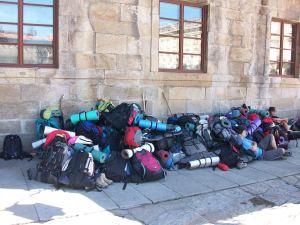
Our planning began back in 2002 on a weekend trip to Santiago while I was working on my Masters at the University of Salamanca. We decided then that we too would return to this city as pilgrims of the Camino and set our sights at 2010, a Jacobean year. During these years, pilgrims not only partake in amazing festivities during the two weeks surrounding July 25, but also receive a plenary indulgence and are able to enter the cathedral through the Puerta Santa, or Holy Door.
After walking the Galician section of the Camino, approximately 160 km, (see previous blog post on walking the Camino), we arrived to Santiago on July 22 and proceeded to the office of the cathedral to wait in line with other pilgrims to get our “compostela”, the document attesting completion of at least 100 km of the Camino. 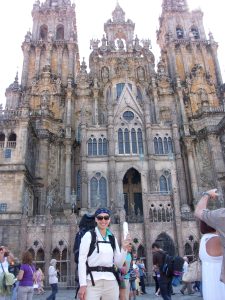 We had hoped to make it to the pilgrims’ mass at noon, but the long line disallowed that and so we checked into the Parador Reyes Catolicos, the oldest hotel in the world, adjacent to the cathedral. http://www.parador.es/en/paradores/parador-de-santiago-de-compostela This hotel was opened by Ferdinand and Isabella back in the 1400’s to house pilgrims arriving to the city. It is now a luxury hotel with a price to match.
We had hoped to make it to the pilgrims’ mass at noon, but the long line disallowed that and so we checked into the Parador Reyes Catolicos, the oldest hotel in the world, adjacent to the cathedral. http://www.parador.es/en/paradores/parador-de-santiago-de-compostela This hotel was opened by Ferdinand and Isabella back in the 1400’s to house pilgrims arriving to the city. It is now a luxury hotel with a price to match. 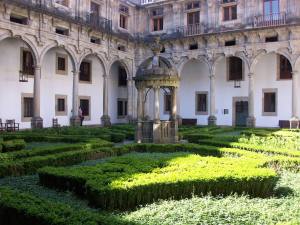 Our reward for our hike was going to be a five night stay here, but after making our reservation a year in advance, I was notified that we would have to vacate the Parador the night of July 24, in the middle of our stay, as the Spanish royal family, including King Juan Carlos I and Queen Sofia, would be staying at the hotel. Well, I never! After I recovered from that, we decided to only stay the first two nights at the Parador and then move for the final three nights to Hotel Virxe Da Cerca http://virxe-da-cerca-compostela.h-rez.com/ located a few blocks behind the cathedral next to the market—a fabulous hotel that was once a Jesuit residence.
Our reward for our hike was going to be a five night stay here, but after making our reservation a year in advance, I was notified that we would have to vacate the Parador the night of July 24, in the middle of our stay, as the Spanish royal family, including King Juan Carlos I and Queen Sofia, would be staying at the hotel. Well, I never! After I recovered from that, we decided to only stay the first two nights at the Parador and then move for the final three nights to Hotel Virxe Da Cerca http://virxe-da-cerca-compostela.h-rez.com/ located a few blocks behind the cathedral next to the market—a fabulous hotel that was once a Jesuit residence.
During our five days enjoying the festivities in Santiago, we attended the pilgrims’ mass twice. The main draw of this mass is in the final minutes of the service when the botafumeiro is swung. This massive incense burner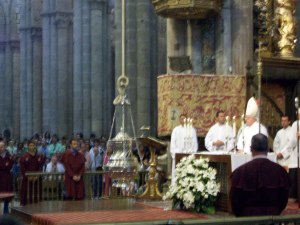 is swung by a team of eight men, spreading the aroma of incense and awe throughout the cathedral. Cameras are flashing and mass goers fill the aisles capturing this moment, giving the mass a bit of a circus feel for a few minutes. What an ingenious way for hundreds of years for the cathedral to freshen the air of a building filled with the non-pleasing scent of hundreds of ripe hikers. Well done!
is swung by a team of eight men, spreading the aroma of incense and awe throughout the cathedral. Cameras are flashing and mass goers fill the aisles capturing this moment, giving the mass a bit of a circus feel for a few minutes. What an ingenious way for hundreds of years for the cathedral to freshen the air of a building filled with the non-pleasing scent of hundreds of ripe hikers. Well done!
Other activities while in Santiago included a variety of parades and processions including the typical gigantes and cabezones (big heads) 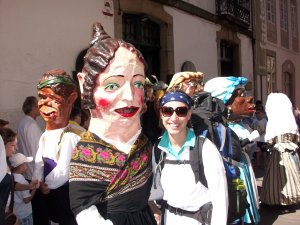 that make appearances at most Spanish festivals. We also checked out the carnival rides set up in the city park and I bravely rode on the huge Ferris wheel set high on a hill looking down on the cathedral. Terrifying!
that make appearances at most Spanish festivals. We also checked out the carnival rides set up in the city park and I bravely rode on the huge Ferris wheel set high on a hill looking down on the cathedral. Terrifying! 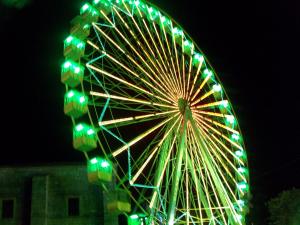 I screamed for most of ride while Russell stood safely on the ground laughing.
I screamed for most of ride while Russell stood safely on the ground laughing.
A fare share of people-watching was also done over these days, much of it on the Rua do Franco, the pedestrian street leading from the cathedral to the park. Where else do you have the chance for a photo op with St. James AND Jesus?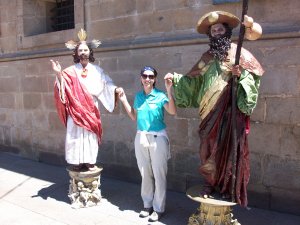
Excellent seafood is the trademark of Galicia and the eateries lining Rua do Franco showcased an endless variety of shellfish in the window cases. 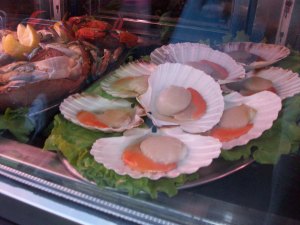 After hearing much talk of the famous mariscada, a heaping plate of shellfish for two, we went to A Barrola http://restaurantebarrola.com/ and dropped 80 Euro on a mariscada lunch.
After hearing much talk of the famous mariscada, a heaping plate of shellfish for two, we went to A Barrola http://restaurantebarrola.com/ and dropped 80 Euro on a mariscada lunch. 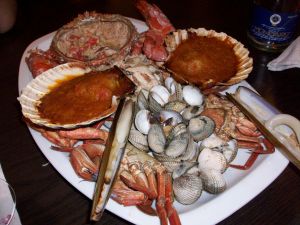 Ouch. As with most of my purchases, I made sure to rationalize it by referencing money saved on other inexpensive meals on the trip! Darn this Catholic guilt of mine…
Ouch. As with most of my purchases, I made sure to rationalize it by referencing money saved on other inexpensive meals on the trip! Darn this Catholic guilt of mine…
The real highlight of the St. James experience though, was the light and sound show in the Plaza del Obradoiro facing the cathedral. This show combining images projected on the cathedral showing the history of St. James, the Camino, and the Galicia region set to music including a group of bagpipers was punctuated with the most amazing fireworks display I have ever seen. Here is a video link to the show—pyrotechnic fans—watch minute 22 till the end. https://www.youtube.com/watch?v=177O9i6Etb8
The show was to begin at 11:30 pm on July 24, the eve of St. James Day. We had attended mass that evening and as we walked out of the cathedral around 7 pm, noticed the plaza already filling with people and so we joined the masses to wait over four hours to snag a spot in the middle, surrounded by others from Spain, Germany, and Uruguay. During these hours spent on the stone plaza, we alternated between levels of discomfort standing, sitting, and even lying down to secure our spots. I was able to run over to a small market and grab a picnic dinner for us—a gourmet affair of Spanish ham on baguettes accompanied by Cheetos and Toblerones. Sipping my water I was jealous of the group next to us having a little sangria party until hours later I noted the lack of bathroom facilities on the plaza. In the middle of our waiting, we were also witness to the arrival of the King and Queen to the Parador. They and other VIPs enjoyed a dinner on the second floor of the hotel before coming onto the balcony to watch the show.
And what a show! Hundreds of thousands of Euros had to have been spent on the production! The tens of thousands of onlookers packed into the square saw the show of a lifetime. The fireworks display in the sky and also on the front of cathedral and simulated “burning of the façade” were overwhelming to say the least, including the ash dropping on the crowd for 30 minutes. It was an emotional show, especially for those of us who had done the Camino and at the end, the streets and bars were packed with revelers but exhaustion hit us hard and forced us to turn in for the night.
Our final day in Santiago was spent on an excursion to the End of the Earth—Finisterre. We endured a three hour ride on a crammed bus—one of the most uncomfortable rides ever—to arrive in the town of Finisterre. After that we walked another 24 km so we could see the kilometer zero sign 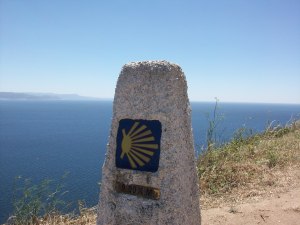 of the Camino near the lighthouse high on a hill outside of town. After spending five hours on the hard stone surface of the plaza the day before and wedged into a bus seat for three hours, the walk felt good
of the Camino near the lighthouse high on a hill outside of town. After spending five hours on the hard stone surface of the plaza the day before and wedged into a bus seat for three hours, the walk felt good 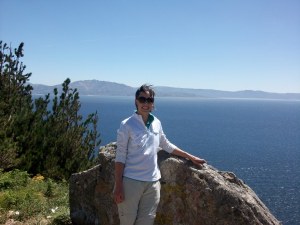 except for the shortage of water on a relatively warm day. I was exhausted as we boarded the same, miserable bus for the three hour return trip. As we pulled into Santiago that evening, we did one last stroll through the city, stopping at the cathedral to enter through the Holy Door, hug the statue of St. James, and reflect before his crypt.
except for the shortage of water on a relatively warm day. I was exhausted as we boarded the same, miserable bus for the three hour return trip. As we pulled into Santiago that evening, we did one last stroll through the city, stopping at the cathedral to enter through the Holy Door, hug the statue of St. James, and reflect before his crypt.
It had been a magical time in the city of Santiago de Compostela, made all the more special by the pilgrimage hike that had brought us here. We were thankful to have chosen 2010 for our trip, knowing that the next Jacobean Year is not until 2021. Who knows—maybe we will be back…
